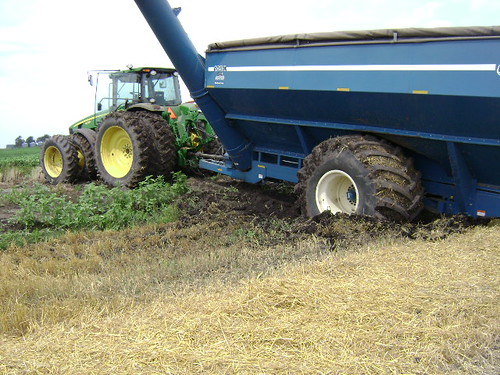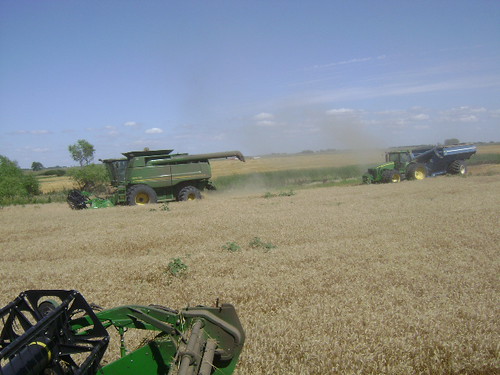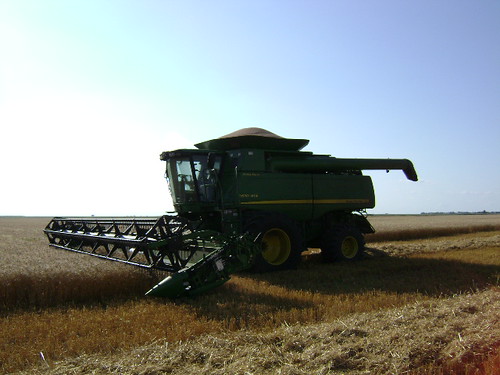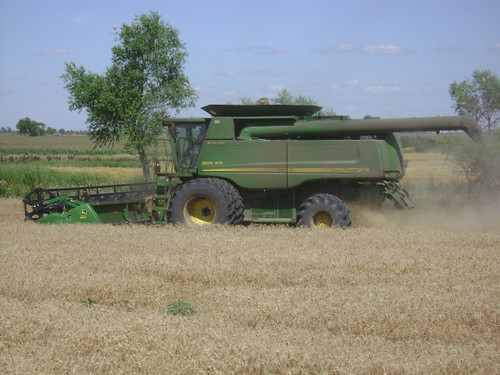08 Aug Scott: Wheat harvest is winding down…one field at a time.
Scott Clark and American Quality have finished harvesting in South Dakota and await their final wheat harvesting job to ripen in North Dakota.
American Quality finished harvesting the last of our winter wheat in South Dakota early this past weekend. It was a great crop across the board with good test weight, protein, and yields in excess of 60 bushels per acre. The ground was wet when we began harvesting, but the hot, windy days soon dried it out and made the harvesting conditions much easier.
On a normal year, we’d be split up harvesting spring wheat all around South Dakota right now. Jada might have said it best: We’d be “here, there and everywhere”. This year, however, each of our clients elected to plant all the ground they could to fall crops due to the wet spring. Although we’re looking forward to a long, busy fall harvest; it’s left us with more time on our hands than we’re used to in August.
We’ll begin taking some grain trailers and equipment to North Dakota this week. We’ll leave some equipment behind in case we stumble onto some wheat that needs to be harvested in South Dakota while the rest of the crew will setup our next home site and touch base with our farmers in the area before returning to South Dakota. If we are unsuccessful at finding more work by the end of the week, we’ll take the last load of equipment up to North Dakota.
We’re expecting to be able to start harvesting some canola around the 15th and should be able to continue harvesting wheat after the canola harvest is wrapped up. Although it’s been a poor year for many harvesters, we’re on track to get 5,000 acres harvested per machine by the time we finish in North Dakota. This will leave us with a lot of work to do this fall to make up for the lack of wheat acres but we’re optimistic that the equipment will keep on running the weather will cooperate. You know you’re in a risky business when you’re dependent on good weather and equipment to run without breakdowns.
Although we’re just now moving to our last stop on the wheat run, we’ve been planning and thinking about fall harvest for some time already. Running a harvesting business is a year-round job as we always have something to prepare for. We’ll be going to pick up corn heads, changing the concave modules in the combines, and performing seasonal maintenance on the equipment before we know it.
Some of our followers have asked about harvesting in wet conditions, so I’ll take a minute to talk about the scenarios wet field conditions present. Wet, muddy fields cause many issues for harvesters to work around. One of the biggest is not being able to drive the trucks into the fields to be loaded. Finding a dry spot that is close to the field and easy to turn trucks around and maneuver a grain cart is probably one of the most difficult things to do. Another issue is harvesting the grain itself in the wet conditions. Although we run flotation duals and four wheel drive on our combines, most crews do not and they find it very difficult, or impossible to harvest in wet conditions.
Not only does it strain the equipment physically and take more horsepower, it also strains the operator to keep the machine under control and harvesting straight patterns through the field. Standing water also presents inexperienced operators with a test—keep the header low enough to get the grain but high enough to be out of the water. I’ve heard horror stories where operators have found that they’re putting water in the bin via the header. The ruts the combines leave also present a hazard for operators and you must plan accordingly in order to keep the cutter bar on the header free of mud.

The trucks took a deserved break over the weekend, but will soon be transporting combines to North Dakota in search of ripe wheat to harvest.

The ground was really wet the first several days of harvesting. As it began to dry up, the grain cart operator let his guard down and paid the price. Thankfully he didn’t try to get out, but rather left it sit where it fell in—making it much easier to pull out.

The grain cart follows a combine around the backside of the field to dump the combines opening up the field. The 60 bushel wheat made it hard to open up a field without getting full—a problem we’re happy to see!

A combine takes a rare rest while waiting for the grain cart to return from the truck.

A combine cuts around a draw and opens up the field.
For more information contact crew@allaboardharvest.com. All Aboard is sponsored by High Plains Journal and DuPont Crop Protection.

Sorry, the comment form is closed at this time.